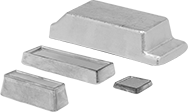Filter by
Material
DFARS Specialty Metals
Export Control Classification Number (ECCN)
REACH
RoHS
Approximate Length
Approximate Diameter
Casting Metals

Melt and pour these alloys into molds to create metal parts and prototypes.
Bismuth and indium alloys expand slightly as they solidify, pushing into the crevices of a mold to produce detailed replicas. These alloys are useful for repairing dies, creating fusible links, and holding delicate parts for machining. Indium alloys have a low melting temperature so they can be cast in molds made from glass, quartz, mica, and ceramic.
Indium Alloy
Material Composition | Approximate | ||||||||||||
|---|---|---|---|---|---|---|---|---|---|---|---|---|---|
| Melting Temperature, °F | Bismuth | Lead | Indium | Tin | Cadmium | Thick. | Wd. | Lg. | Dia. | Wt., lbs. | Each | ||
| 117° | 45% | 23% | 19% | 8% | 5% | 1/4" | 2" | 4 1/2" | __ | 1/2 | Sheet and Bar | 0000000 | 0000000 |
| 136° | 49% | 18% | 21% | 12% | __ | 1/4" | 1 7/8" | 4 1/2" | __ | 1/2 | Sheet and Bar | 0000000 | 000000 |
| 140° | 48% | 25% | 5% | 13% | 9% | 1/2" | __ | __ | 3 1/2" | 1 | Rod and Disc | 00000000 | 000000 |
| 147° | 48% | 25% | 4% | 13% | 10% | 1/2" | __ | __ | 3 1/2" | 1 | Rod and Disc | 00000000 | 000000 |

























